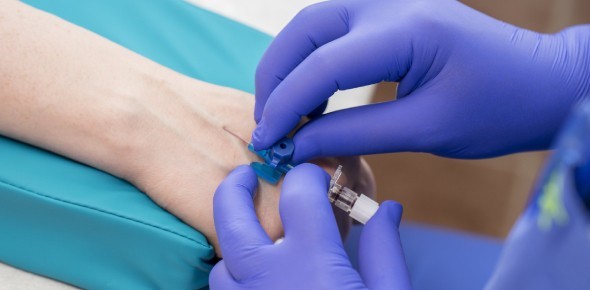A nurse is reviewing the ABGs of a client who has pneumonia. The nurse should identify which of the following findings is an indication of respiratory acidosis.
PaO2 86 mm Hg.
pH 7.4.
HCO3 16 mEq/L.
PaCO2 58 mm Hg.
The Correct Answer is D
Choice A rationale:
A PaO2 value of 86 mm Hg is within the normal range (80-100 mm Hg) and does not indicate respiratory acidosis. PaO2 measures the partial pressure of oxygen in arterial blood.
Choice B rationale:
A pH of 7.4 is within the normal range (7.35-7.45) and does not indicate respiratory acidosis. The pH reflects the acidity or alkalinity of the blood.
Choice C rationale:
An HCO3 (bicarbonate) level of 16 mEq/L is within the normal range (22-28 mEq/L) and does not indicate respiratory acidosis. HCO3 is a measure of the metabolic component of the body's acid-base balance.
Choice D rationale:
This is the correct choice. A PaCO2 value of 58 mm Hg is elevated and indicates respiratory acidosis. PaCO2 measures the partial pressure of carbon dioxide in arterial blood, and an elevated value suggests the presence of excess carbon dioxide, leading to acidosis.
Nursing Test Bank
Naxlex Comprehensive Predictor Exams
Related Questions
Correct Answer is B
Explanation
Choice A rationale:
Increased peristalsis would be a positive sign and not indicative of postoperative paralytic ileus. Increased peristalsis would mean the bowel is functioning well.
Choice B rationale:
Abdominal distension is a classic sign of postoperative paralytic ileus, where the bowel's motility is reduced or absent. This condition can lead to a buildup of gas and fluids, causing the abdomen to become distended.
Choice C rationale:
Proximal high-pitched bowel sounds can be a normal finding after surgery, but they are not indicative of paralytic ileus. They may even be heard as the bowel recovers its motility.
Choice D rationale:
Passing flatus is a positive sign, as it indicates that the bowel is working and the patient is passing gas. This is not indicative of a postoperative paralytic ileus, which is characterized by the absence of bowel movement.
Correct Answer is C
Explanation
Verify that the client has adequate IV access.

Choice A rationale:
Administering vasopressin to the client might be necessary to manage the hemorrhage, but before any medication administration, it is crucial to ensure the client has adequate IV access. Vasopressin is a vasoconstrictor and can help control bleeding from esophageal varices, but its effectiveness relies on IV access to deliver the medication promptly.
Choice B rationale:
Requesting blood from the blood bank is essential for a client experiencing significant bleeding. However, the priority action is to verify IV access to administer any necessary blood products.
Choice C rationale:
This is the correct choice. Before initiating any interventions, ensuring the client has appropriate IV access is a priority. Adequate IV access is necessary to administer fluids, medications, or blood products promptly and effectively stabilize the client's blood pressure.
Choice D rationale:
Inserting an indwelling urinary catheter is not the priority action in this situation. While monitoring urine output is important, it should be secondary to addressing the client's hypotension and hemorrhage.
Whether you are a student looking to ace your exams or a practicing nurse seeking to enhance your expertise , our nursing education contents will empower you with the confidence and competence to make a difference in the lives of patients and become a respected leader in the healthcare field.
Visit Naxlex, invest in your future and unlock endless possibilities with our unparalleled nursing education contents today
Report Wrong Answer on the Current Question
Do you disagree with the answer? If yes, what is your expected answer? Explain.
Kindly be descriptive with the issue you are facing.
